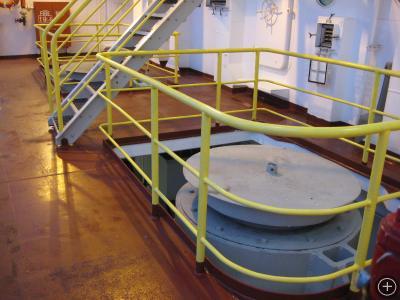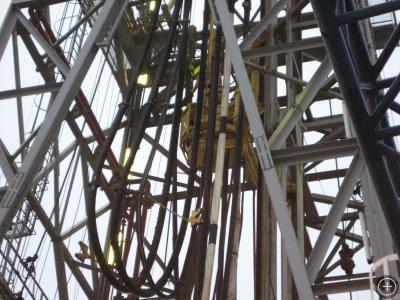How Do You Stop the Motion of the Ocean?
ABOARD THE JOIDES RESOLUTION, ON THE BERING SEA– The JOIDES Resolution is equipped with some of the best devices available to do her job. She is designed to move quickly on the ocean carrying a great deal of equipment and people to remote locations, and the ocean can be a rough place. But a problem arises when you are on the ever changing surface of the ocean and you are trying to drill a hole thousands of meters below the surface. How do you hold the drill steady when it is mounted to a ship that moves with the flow of the water? That is today’s topic.
As we stop in one spot to begin drilling, the ship’s dynamic positioning computer system goes to work. The two thrusters in the aft of the ship are joined by another ten placed around the ship. Running constantly once we are in place over our location, they keep us steady. The beacon is a device that is dropped to the ocean floor to aid in maintaining our location. It is somewhat redundant with the ships other navigational equipment, but it is there just in case we there are any failures.
In addition to the thrusters, the derrick has what are called heave compensators. Most drilling problems are related to variations of the composition of sediment being drilled, and or problems clearing out the hole. When you add a rocking ship into the equation, things could get complicated. To combat this, the JR employs both passive and active heave compensation. The passive compensator is a reactive air cushion that reduces vertical movement. But since it has to overcome friction in the seals, it reacts better in rougher seas. In six foot seas it keeps the drill steady to about 3 feet relative to the sea floor, while in twelve foot seas it can keep it within around 2 feet relative to the sea floor. Pretty impressive considering this is several kilometers beneath the ship! The active heave compensator uses hydraulic power to overcome that friction, and can improve the heave compensation to within about 4 inches of motion at the rig floor. How’s that for calm?
And now this positioning equipment is so precise that a new problem has emerged. Tides. Tides vary according to the position of the moon and sun, because of the changing gravitational forces they exert on the oceans. In the past it was difficult to see these effects, and in short time periods you’d never notice a difference. But now due to the quality of heave compensation and the accuracy of the depth measurements, tides can be seen affecting drilling depths when we are drilling at one site over multiple days. Now that’s pretty amazing. One of the new things we are looking at on this expedition is tidal charts for this area, in an attempt to predict and account for the variations in ocean depth at our location. Maybe this will play a part in all future IODP drilling projects?

 No comments
No comments 








